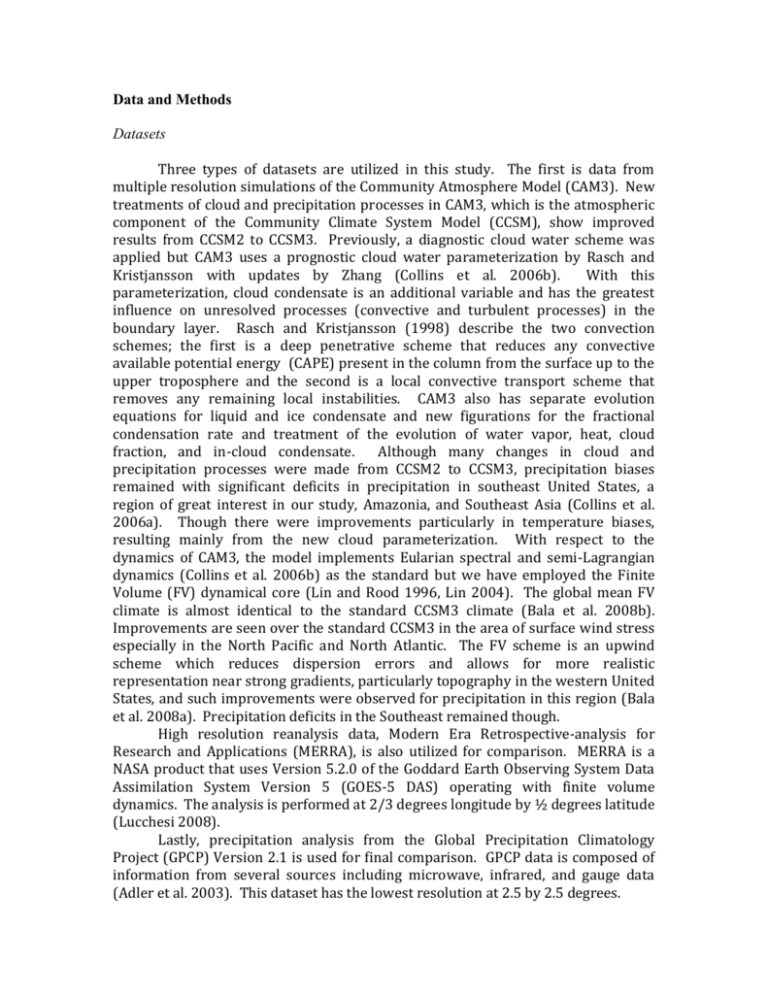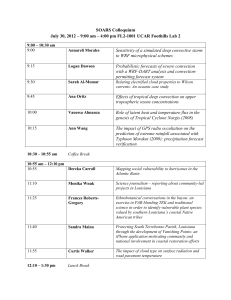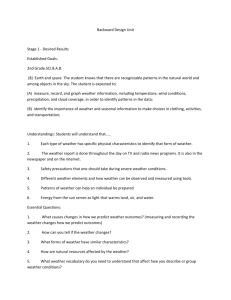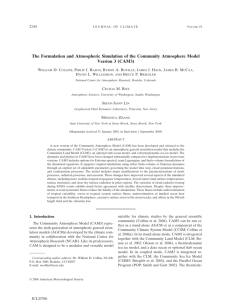Data and Methods section
advertisement

Data and Methods Datasets Three types of datasets are utilized in this study. The first is data from multiple resolution simulations of the Community Atmosphere Model (CAM3). New treatments of cloud and precipitation processes in CAM3, which is the atmospheric component of the Community Climate System Model (CCSM), show improved results from CCSM2 to CCSM3. Previously, a diagnostic cloud water scheme was applied but CAM3 uses a prognostic cloud water parameterization by Rasch and Kristjansson with updates by Zhang (Collins et al. 2006b). With this parameterization, cloud condensate is an additional variable and has the greatest influence on unresolved processes (convective and turbulent processes) in the boundary layer. Rasch and Kristjansson (1998) describe the two convection schemes; the first is a deep penetrative scheme that reduces any convective available potential energy (CAPE) present in the column from the surface up to the upper troposphere and the second is a local convective transport scheme that removes any remaining local instabilities. CAM3 also has separate evolution equations for liquid and ice condensate and new figurations for the fractional condensation rate and treatment of the evolution of water vapor, heat, cloud fraction, and in-cloud condensate. Although many changes in cloud and precipitation processes were made from CCSM2 to CCSM3, precipitation biases remained with significant deficits in precipitation in southeast United States, a region of great interest in our study, Amazonia, and Southeast Asia (Collins et al. 2006a). Though there were improvements particularly in temperature biases, resulting mainly from the new cloud parameterization. With respect to the dynamics of CAM3, the model implements Eularian spectral and semi-Lagrangian dynamics (Collins et al. 2006b) as the standard but we have employed the Finite Volume (FV) dynamical core (Lin and Rood 1996, Lin 2004). The global mean FV climate is almost identical to the standard CCSM3 climate (Bala et al. 2008b). Improvements are seen over the standard CCSM3 in the area of surface wind stress especially in the North Pacific and North Atlantic. The FV scheme is an upwind scheme which reduces dispersion errors and allows for more realistic representation near strong gradients, particularly topography in the western United States, and such improvements were observed for precipitation in this region (Bala et al. 2008a). Precipitation deficits in the Southeast remained though. High resolution reanalysis data, Modern Era Retrospective-analysis for Research and Applications (MERRA), is also utilized for comparison. MERRA is a NASA product that uses Version 5.2.0 of the Goddard Earth Observing System Data Assimilation System Version 5 (GOES-5 DAS) operating with finite volume dynamics. The analysis is performed at 2/3 degrees longitude by ½ degrees latitude (Lucchesi 2008). Lastly, precipitation analysis from the Global Precipitation Climatology Project (GPCP) Version 2.1 is used for final comparison. GPCP data is composed of information from several sources including microwave, infrared, and gauge data (Adler et al. 2003). This dataset has the lowest resolution at 2.5 by 2.5 degrees. For each data source and resolution, analysis was conducted for time frames of overlapping available data but five years were studied in more detail to capture a summer characterized by drought and one of flooding. The Southeast U.S. had drought conditions in 1988 and the upper Midwest had flood conditions in 1993 so arbitrarily selected years surrounding and including these two periods were chosen for further study (1986, ‘88, ‘90, ‘93, and ’95). Methods Adler, R. F., G. J. Huffman, A. Chang, R. Ferraro, P. P. Xie, J. Janowiak, B. Rudolf, U. Schneider, S. Curtis, D. Bolvin, A. Gruber, J. Susskind, P. Arkin & E. Nelkin (2003) The version-2 global precipitation climatology project (GPCP) monthly precipitation analysis (1979-present). Journal of Hydrometeorology, 4, 1147-1167. Bala, G., R. B. Rood, D. Bader, A. Mirin, D. Ivanova & C. Drui (2008a) Simulated climate near steep topography: Sensitivity to numerical methods for atmospheric transport. Geophysical Research Letters, 35. Bala, G., R. B. Rood, A. Mirin, J. McClean, K. Achutarao, D. Bader, P. Gleckler, R. Neale & P. Rasch (2008b) Evaluation of a CCSM3 simulation with a finite volume dynamical core for the atmosphere at 1 degrees latitude x 1.25 degrees longitude resolution. Journal of Climate, 21, 1467-1486. Collins, W. D., C. M. Bitz, M. L. Blackmon, G. B. Bonan, C. S. Bretherton, J. A. Carton, P. Chang, S. C. Doney, J. J. Hack, T. B. Henderson, J. T. Kiehl, W. G. Large, D. S. McKenna, B. D. Santer & R. D. Smith (2006a) The Community Climate System Model version 3 (CCSM3). Journal of Climate, 19, 2122-2143. Collins, W. D., P. J. Rasch, B. A. Boville, J. J. Hack, J. R. McCaa, D. L. Williamson, B. P. Briegleb, C. M. Bitz, S. J. Lin & M. H. Zhang (2006b) The formulation and atmospheric simulation of the Community Atmosphere Model version 3 (CAM3). Journal of Climate, 19, 2144-2161. Lin, S. J. (2004) A "vertically Lagrangian'' finite-volume dynamical core for global models. Monthly Weather Review, 132, 2293-2307. Lin, S. J. & R. B. Rood (1996) Multidimensional flux-form semi-Lagrangian transport schemes. Monthly Weather Review, 124, 2046-2070. Lucchesi, R. 2008. File Specification for MERRA Products. Greenbelt: Global Modeling and Assimilation Office.










